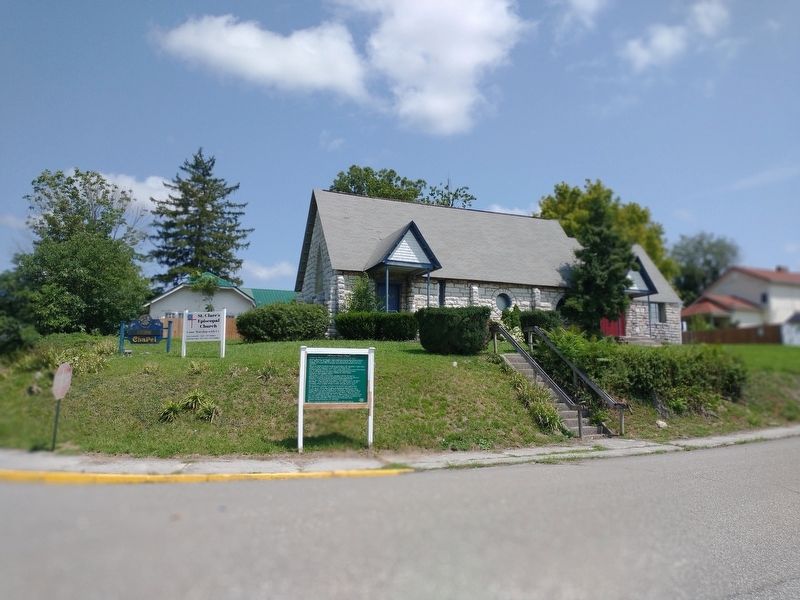LaFollette in Campbell County, Tennessee — The American South (East South Central)
Historic Stone Chapel
Completed in December, 1909, this chapel was erected for and by a small colony of Italian, Bavarian, and English Catholic families answering the call of Indiana industrial baron, Harvey M. Lafollette, to labor on the railroad, dig coal, and operate coke ovens. Lafollette, who re-named Big Creek Gap, donated the land and contributed to the cost of construction.
The site was selected ("on the brow of a hill one square beyond Mr. Lafollette's [Glen Oaks] residence"), and the original 22 ft. x 50 ft. structure was designed by Fr. Emmanuel Francis Callahan (1871-1944), a young, tireless second-generation Irish-American priest. A Knoxville native who preferred riding horseback throughout his assigned territory of 34 East Tennessee counties, Callahan also wielded a hammer alongside men of the Lafollette Mission.
First planned as a frame or brick structure, depending on funding, the chapel was ultimately erected of stone donated by the L&N railroad, cut and fitted by skilled local stonemasons - a rarity among missions of the period and which likely insured its longevity. In a letter to his bishop dated July 29, 1909, Callahan reported, "the chapel at Lafollette…is of blue limestone and the [sic] of my own design and plans and the first stone building I ever assembled, I believe it will be a little gothic gem of a chapel."
The chapel features a matching set of windows in the distinctive shape of Greek letters, 'I', 'O', and 'A' ("I am the alpha and omega, the beginning and the end"), and a large triangular window at one end. Originally, all were stained glass. The triangular window, depicting Christ in the Garden of Gethsemane, was donated by Angelo Anthony Dusini [1868-1941] a public-spirited immigrant coal miner from Vestoria, Italy who resided 36 years in Lafollette until his death. In 1994, the Dusini window was incorporated into the larger Our Lady of Perpetual Help Catholic church a short distance east of this site. An anteroom was added (right end) in 1950, and except for this and minor interior renovations, the chapel remains true to its 1909 design.
This site is under the stewardship of the Campbell County Historical Society.
Erected by Lafollette Beautification and Enhancement Board.
Topics. This historical marker is listed in these topic lists: Architecture • Churches & Religion. A significant historical date for this entry is July 29, 1909.
Location. 36° 23.07′ N, 84° 7.058′ W. Marker is in LaFollette, Tennessee, in Campbell County. Marker is at the intersection of East Central Avenue (Tennessee Route 63) and South 6th Street, on the right when traveling north on East Central Avenue. Touch for map. Marker is at or near this postal address: 103 S 6th St, La Follette TN 37766, United States of America. Touch for directions.
Other nearby markers. At least 8 other markers are within 8 miles of this marker, measured as the crow flies. Glen Oaks (approx. 0.2 miles away); Howard "Louie Bluie" Armstrong (approx. ¼ mile away); a different marker also named Howard "Louie Bluie" Armstrong (approx. 0.3 miles away); Big Creek Gap (approx. half a mile away); Campbell County War Memorial (approx. 5.2 miles away); Stone Mill (approx. 7.3 miles away); The Civilian Conservation Corps and Cove Lake State Park (approx. 7.4 miles away); Indian Mounds (approx. 7.7 miles away). Touch for a list and map of all markers in LaFollette.
Credits. This page was last revised on August 28, 2020. It was originally submitted on August 27, 2020, by Tom Bosse of Jefferson City, Tennessee. This page has been viewed 342 times since then and 56 times this year. Photos: 1, 2. submitted on August 27, 2020, by Tom Bosse of Jefferson City, Tennessee. • Devry Becker Jones was the editor who published this page.

